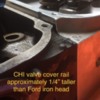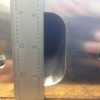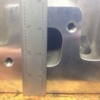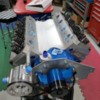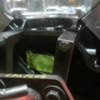Don't know if it helps. chi heads/chi intake, sides used an incorrect homemade gasket instead of the .060 chi gasket that was destroyed by the builder when they had to take it apart again. Normally I think only the bottom is siliconed.
Larry, I cam across a similar issue a number of years ago. The CHI 3V heads and intakes are dimensionally different than Ford 335 series heads. Besides the port location, the head is 1/4" wider in the direction the moves the face of the intake ports inward. This means CHI 3V Heads wont interchange with Ford dimensioned intakes and CHI 3V intakes wont mount to Ford spec 335 series heads without slotting the intake bolt holes.
I used this to advantage on fitting a dual plane 3V 9.5 intake to match C302B high port heads as the mismatch cause the ports and bolt holes to line up near perfectly on that combination but I actually had to mill a little off the intake land that seals the valley rail for it to land properly. When I inquired of CHI about the mismatch and suggested it may be appropriate to state such variances on their website they were nothing short of indignant with me as to why anyone would use anything but CHI lids with CHI heads.....which didn't sit too well with me but Ce La Vie. More recently I've noticed many of there intakes have slotted mounting holes but I don't know if enough to accommodate the 3V mismatch.
During that same CHI exchange, I asked if that was the case with the rest of their product line, namely the so-called "4V heads". They said 4Vs had standard 335 series port position and mounting pattern on both intake and exhaust. Just because they say that may not mean the head dimension you are observing isn't different and they have compensated on the other machining of the mounting locations. Just wondering if you've verified the exhaust side and port position are what you expected.
I did a write up on the subject over at the 351 forum; search "CHI 3V Heads and Intake" there. I'd say just make an aluminum spacer and screw/glue it to your block instead of the intake so the issue doesn't repeat in the event of future intake swaps.
Best,
Kelly
I used this to advantage on fitting a dual plane 3V 9.5 intake to match C302B high port heads as the mismatch cause the ports and bolt holes to line up near perfectly on that combination but I actually had to mill a little off the intake land that seals the valley rail for it to land properly. When I inquired of CHI about the mismatch and suggested it may be appropriate to state such variances on their website they were nothing short of indignant with me as to why anyone would use anything but CHI lids with CHI heads.....which didn't sit too well with me but Ce La Vie. More recently I've noticed many of there intakes have slotted mounting holes but I don't know if enough to accommodate the 3V mismatch.
During that same CHI exchange, I asked if that was the case with the rest of their product line, namely the so-called "4V heads". They said 4Vs had standard 335 series port position and mounting pattern on both intake and exhaust. Just because they say that may not mean the head dimension you are observing isn't different and they have compensated on the other machining of the mounting locations. Just wondering if you've verified the exhaust side and port position are what you expected.
I did a write up on the subject over at the 351 forum; search "CHI 3V Heads and Intake" there. I'd say just make an aluminum spacer and screw/glue it to your block instead of the intake so the issue doesn't repeat in the event of future intake swaps.
Best,
Kelly
it's a shame CHI goes to the effort to produce their product but not precise comprehensive fitment info needed due to their own choice to use proprietary dimensions
never been interested in CHI for this reason
never been interested in CHI for this reason
Many people think CHI did that to confound the copiers. Sort of amusing when you consider they're copying a Ford 335 series platform themselves. Doesn't make sense to me cuz it's just as easy to copy that too. It seems more likely to me they did it to enable/gain another .25-.30" port roof height.
Despite my experience I think they make a good product and save a few quality problems which all manufacturers suffer from time to time, in my view the only advantage if any they offer over my 30+ year old high port Ford heads is combustion chamber design but I still say the rest is more about who is working the parts than the parts themselves.
Best,
Kelly
Despite my experience I think they make a good product and save a few quality problems which all manufacturers suffer from time to time, in my view the only advantage if any they offer over my 30+ year old high port Ford heads is combustion chamber design but I still say the rest is more about who is working the parts than the parts themselves.
Best,
Kelly
Did some side-by-side comparisons today with the CHI aluminum heads and my old Ford iron heads.
Because the CHI heads are brand new, and the iron heads have likely been milled some time in their history, definitive comparisons are subject to some qualifications when comparing the height of the threaded holes for the headers and intake, but it appears both have been raised to some degree, the headers most likely definitively raised even accounting for some iron head milling.
I still need to take photos of the performer manifold when the new CHI heads are bolted in place to see if it also displays a 0.270” gap as seen with the Blue Thunder manifold. Stand by for that.
But when it comes to the valve cover rails, there is no question that CHI has raised them by roughly 1/4”.
Larry
Because the CHI heads are brand new, and the iron heads have likely been milled some time in their history, definitive comparisons are subject to some qualifications when comparing the height of the threaded holes for the headers and intake, but it appears both have been raised to some degree, the headers most likely definitively raised even accounting for some iron head milling.
I still need to take photos of the performer manifold when the new CHI heads are bolted in place to see if it also displays a 0.270” gap as seen with the Blue Thunder manifold. Stand by for that.
But when it comes to the valve cover rails, there is no question that CHI has raised them by roughly 1/4”.
Larry
Attachments
valve cover rail height is inconsequential,
measure from the dowel hole (zero point on the print) to the intake face, and add 1/2 the diameter of the dowel hole to the 'from' measurement. measure the dowel hole of each head and compute as they may be slightly different
again, with one of each head on the block, set an intake on and the difference will be crystal clear
measure from the dowel hole (zero point on the print) to the intake face, and add 1/2 the diameter of the dowel hole to the 'from' measurement. measure the dowel hole of each head and compute as they may be slightly different
again, with one of each head on the block, set an intake on and the difference will be crystal clear
Did you measure the port height?
quote:Originally posted by George P:
Did you measure the port height?
there's a direct comparison that should correspond
easy way to compare the dowel holes, use the dowels to mate the heads to each other
intake & exhaust faces should match
i think i may / i think i might
Attachments
have a pic or 2 of CHI 4V port height!
Attachments
Former Member
My solution with AFD heads. .125 aluminum.
Attachments
Nicely Done!
what seals the sides, just RTV along the edge?
screws use the existing holes in the china wall?
is your cover trapped below the heads and mitered at the edge?
Edelbrock markets some valley covers, and there's an ebay seller that offers a piece with flanges turned up 45*, could be used as a head start or maybe contact him & see if he's open to suiting specific needs
https://www.ebay.com/itm/NEW-L...&hash=item51f212ecde
what seals the sides, just RTV along the edge?
screws use the existing holes in the china wall?
is your cover trapped below the heads and mitered at the edge?
Edelbrock markets some valley covers, and there's an ebay seller that offers a piece with flanges turned up 45*, could be used as a head start or maybe contact him & see if he's open to suiting specific needs
https://www.ebay.com/itm/NEW-L...&hash=item51f212ecde
Because the aluminum heads are brand new and the iron heads may have been milled more than once or twice in the last 45 years, I am not sure we can ever come to a definite determination as to why the gap is so large.
My engine builder has fabricated aluminum spacers, the dry fit gap is .060 and RTV silicone will take care of that quite easily.
Larry
My engine builder has fabricated aluminum spacers, the dry fit gap is .060 and RTV silicone will take care of that quite easily.
Larry
Attachments
milling of the cylinder head deck sealing surface does not alter the china wall gap
the intake faces of the heads remain at the same angle, in the same plane and at the same distance apart from each other. am i seeing things or is the intake face of the alloy head 'proud' of the break point of the china wall and the deck surface, intruding into the intake manifolds' space?
glad to hear you were able to come up with a solution
the intake faces of the heads remain at the same angle, in the same plane and at the same distance apart from each other. am i seeing things or is the intake face of the alloy head 'proud' of the break point of the china wall and the deck surface, intruding into the intake manifolds' space?
glad to hear you were able to come up with a solution
I understand your concern about the head intrusion issue but the photo is not quite clear on this, and I have not viewed the engine in person.
I intend to visit my builder tomorrow and that will be one of the issues I will check. George previously mentioned this, thank you for your reminder.
Larry
I intend to visit my builder tomorrow and that will be one of the issues I will check. George previously mentioned this, thank you for your reminder.
Larry
Add Reply
Sign In To Reply


